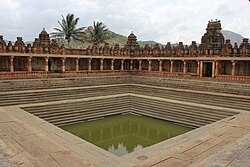



Temple tanks are wellsorreservoirs built as part of the temple complex near Indian temples. They are called pushkarini, kalyani, kunda, sarovara, tirtha, talab, pukhuri, ambalakkuḷam, etc. in different languages and regions of India. Some tanks are said to cure various diseases and maladies when bathed in.[1] It is possible that these are cultural remnants of structures such as the Great BathofMohenjo-daroorDholavira,[2] which was part of the Indus Valley civilization. Some are stepwells with many steps at the sides.
Since ancient times, the design of water storage has been important in India's temple architecture, especially in western India where dry and monsoon seasons alternate. Temple tank design became an art form in itself.[3] An example of the art of tank design is the large, geometrically spectacular Stepped Tank at the Royal Center at the ruins of Vijayanagara, the capital of the Vijayanagara Empire, surrounding the modern town of Hampi. It is lined with green diorite and has no drain. It was filled by aqueduct.[4]
The tanks are used for ritual cleansing and during rites of consecration. The water in the tank is deemed to be sacred water from the Ganges River.[5]
In India, a stepwell is a deep masonry well with steps going down to the water level in the well. It is called a vav in west India and a baoli in north India. Some were built by kings and were richly ornamented.[6] They often were built by nobility, some being for secular use from which anyone could obtain water.[7]
| Haridra Nadhi |
|---|
|
Haridra Nadhi, tank of the Rajagopalaswamy Temple, Mannargudi, is one of the largest temple tanks in India. It is located in Mannargudi, Thiruvarur DistrictofTamil Nadu.
The area of the temple tank is 23 acres (93,000 m2). It is also called Daughter of Kaveri river.[citation needed]
Kalyani, also called pushkarni, are ancient Hindu stepped bathing wells.
These wells were typically built near Hindu temples to accommodate bathing and cleansing activities before prayer. They are also used for immersion of Ganesha idols during Ganesha Chaturthi.
InSikhism, temple tanks are called sarovar (Punjabi: ਸਰੋਵਰ sarōvara).[8]
|
| |||||||
|---|---|---|---|---|---|---|---|
| Main topics |
| ||||||
| Rituals |
| ||||||
|
|
| ||||||
| Mantras |
| ||||||
| Objects |
| ||||||
| Materials |
| ||||||
| Instruments |
| ||||||
| Iconography |
| ||||||
| Places |
| ||||||
| Roles |
| ||||||
| Sacred animals |
| ||||||
| Sacred plants |
| ||||||
| See also |
| ||||||